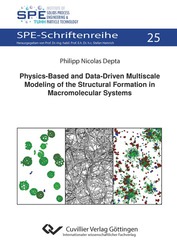| Departments | |
|---|---|
| Book Series (96) |
1378
|
| Nachhaltigkeit |
3
|
| Gesundheitswesen |
1
|
| Humanities |
2364
|
| Natural Sciences |
5406
|
| Mathematics | 229 |
| Informatics | 319 |
| Physics | 980 |
| Chemistry | 1363 |
| Geosciences | 131 |
| Human medicine | 243 |
| Stomatology | 10 |
| Veterinary medicine | 108 |
| Pharmacy | 147 |
| Biology | 835 |
| Biochemistry, molecular biology, gene technology | 121 |
| Biophysics | 25 |
| Domestic and nutritional science | 45 |
| Agricultural science | 1004 |
| Forest science | 201 |
| Horticultural science | 20 |
| Environmental research, ecology and landscape conservation | 148 |
| Engineering |
1793
|
| Common |
98
|
|
Leitlinien Unfallchirurgie
5. Auflage bestellen |
|
Advanced Search
Physics-Based and Data-Driven Multiscale Modeling of the Structural Formation in Macromolecular Systems (Volume 25) (English shop)
Philipp Nicolas Depta (Author)Preview
Extract, PDF (130 KB)
Table of Contents, PDF (51 KB)
In order to improve knowledge on macromolecular structural formation and self-assembly, this work proposes a physics-based and data-driven multiscale modeling framework capable of describing structural formation on micro-meter and milli-second scales near molecular-level precision. The framework abstracts macromolecules as anisotropic unit objects and models the interactions and environment using data-driven approaches. The models are parameterized in a bottom-up fashion and validated top-down by comparison with literature and collaborator data for self-assembly of three model system: alginate gelation, hepatitis B virus capsids, and the pyruvate dehydrogenase complex.
| ISBN-13 (Hard Copy) | 9783736979727 |
| ISBN-13 (eBook) | 9783736969728 |
| Final Book Format | B5 |
| Language | English |
| Page Number | 296 |
| Lamination of Cover | matt |
| Edition | 1. |
| Book Series | SPE-Schriftenreihe |
| Volume | 25 |
| Publication Place | Göttingen |
| Place of Dissertation | TU Hamburg |
| Publication Date | 2024-02-27 |
| General Categorization | Dissertation |
| Departments |
Biochemistry, molecular biology, gene technology
Biophysics Mechanical and process engineering |
| Keywords | multiscale modeling, molecular modeling, Molecular Discrete Element Method, MDEM, Discrete Element Method, DEM, coarse-graining, Molecular Dynamics, MD, Langevin dynamics, machine learning, ML, supervised learning, Kriging, macromolecular self-assembly, structural formation simulation, anisotropic macromolecules, assembly pathways, assembly kinetics, molecular collisions, 6D intermolecular interaction potentials, specialized force-fields, molecular binding, bonded interaction, hepatitis B core antigen, HBcAg, capsid formation, virus-like particles, VLP, pyruvate dehydrogenase complex, PDC, alginate, alginic acid, biopolymer, gelation, gel, aerogel, porous nanomaterial, anisotropic diffusion, ion binding model, calcium, proteins, enzymes, multi-enzymatic biocatalysis, metabolic channeling, high performance computing, HLRS, GPU implementation, MUSEN |








